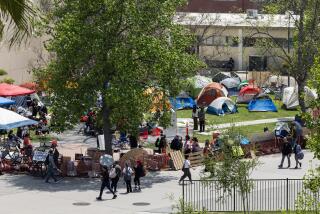Plan to Expand Renewal Area Draws Mixed Reviews : Ventura: Some property owners and merchants hail a proposal to redevelop more of downtown. But others are wary.
Plans to expand Ventura’s redevelopment area and generate tens of millions of new tax dollars for the city have divided many of the property owners and merchants doing business downtown.
Some hail it as a recipe for revitalizing a stagnant commercial core and a first step in establishing Ventura as a tourist destination such as Santa Barbara or San Luis Obispo.
Others are suspicious of the land-grabbing powers that a redevelopment agency is granted under the law, and say government should not be in the development business.
City officials call redevelopment a tool to generate funds for ambitious projects that might otherwise never get built.
They have a long list of capital improvements they say would make Ventura more popular with tourists, and plan on more than 1,000 residential units being built within walking distance of those attractions.
“It’s not a money-grabbing thing,” Councilman Gregory L. Carson said. “Redevelopment agencies just have a little more flexibility in assisting projects.”
California’s redevelopment law allows local governments to designate certain areas as “blighted.” The areas then generate revenue by diverting any new property taxes to a special fund.
Agencies often borrow against the anticipated increase in property taxes and spend the money on renovations in run-down areas.
In 1978, the Ventura City Council established a 155-acre redevelopment zone downtown--an area generally bounded by Poli Street and Fix Way to the north, California 33 to the west, the Ventura Freeway to the south and Palm Street to the east.
Since then, that area has generated more than $20 million in so-called tax-increment funding for the city Redevelopment Agency, which in following years spent most of the money developing the Mission Plaza shopping center at Ventura Avenue.
Subsequent projects included renovating Figueroa Street, sprucing up Main Street and helping to build the new state Court of Appeal on Santa Clara Street.
At this point, all but $1 million or so of the money has been spent or committed to existing projects.
“Our Redevelopment Agency is almost at the limit,” Carson said. “So it would virtually cease to exist if we’re not able to raise the cap. I don’t think that’s what the city wants or needs.”
Under the amendment being considered by the Redevelopment Agency, the area’s boundaries would be extended five blocks east to Ash Street, as well as attaching a wedge of land running between San Jon Road and the Southern Pacific Railroad tracks. All told, the expansion would add another 95 acres to the district.
City analysts estimate that the area would generate $90 million or more over the next 30 years--money the city could use to build downtown parking structures, a convention center or any of a series of proposals being pitched by developers.
But some landowners are afraid that their property would be condemned under eminent-domain laws, which allow governments to acquire parcels at “fair-market” prices for the good of the city.
“I’m worried about the ability of the city to condemn my private property, and that’s what they can do,” said Cliff Linder, whose Poinsettia Collectables shop on Main Street would be included in the new redevelopment zone.
“I’m for an upbeat downtown, but I don’t think we need the city’s involvement to achieve it,” he said. “What they want to achieve could be achieved through tax breaks.”
Despite spending more than $300,000 on a downtown Specific Plan and a feasibility study on the redevelopment area amendment, city officials say the expansion proposal is not a done deal.
Before the City Council, sitting as the Redevelopment Agency, votes on the amendment in June, a series of public meetings will be held to gather community input.
The first hearing is scheduled tonight at City Hall.
Following another informational meeting March 16, a panel of residents will be elected to an advisory committee, which will present its recommendations to the City Council.
“Even though the rules have changed in the past few years, redevelopment is still a mechanism for the city to be more proactive in terms of economic development,” Mayor Tom Buford said.
But, he added, “I will maintain an open mind until I’ve heard what the process produces as far as people coming forward with comments and concerns.”
Like other council members, Buford said most of the current revitalization efforts could not have been funded without redevelopment.
For example, the city is in the midst of a four-month renovation of California and Main streets, which by midsummer will boast wider sidewalks and resurfaced roads, as well as new trees and street lamps within the downtown core.
Late last month, workers chopped down dozens of ficus trees along the two streets to make way for the palms and honeylocusts that will take their place.
“All of this is part of the whole move the city has taken to improve the economic climate of the community,” said Sandy Smith, a downtown restaurateur who said the revitalization efforts already are paying off.
“The movement in the last two years has been dramatic,” Smith said. “We went from having no coffee shops to having what, 10? People are starting to see Ventura with a heart now.”
Nonetheless, some property owners say that revitalization is better left to the private sector, where the free market dictates whether a landowner chooses to renovate a storefront.
Downtown “was designated as a redevelopment zone 17 years ago,” said Virginia Gould, who owns a building in the 300 block of Main Street. “There have been some improvements, but they really haven’t produced a great deal of revenue.
“Most of those businesses just hang on by their teeth,” Gould said. “They’re not making any money.”
But city planner Patrick Richardson said something must be done about the aged and blighted downtown, where more than half the buildings are made of masonry that is not reinforced.
The downtown Specific Plan adopted last year calls for property owners to reinforce their buildings before they make any other improvements. Some redevelopment money could be used to make low-interest loans to those owners, he said.
Last year, much of downtown Fillmore was destroyed during the Northridge earthquake because buildings were made of unreinforced masonry, Richardson said. “That could have happened here, but we just weren’t close enough.”
Meanwhile, a major fault runs through the hills immediately behind City Hall, Richardson said.
“It’s not economically feasible for property owners to go out and get (commercial) loans on these projects when we could offer low-interest loans,” he said.
Richardson also said the Redevelopment Agency is vital to piecing together parcels of land for projects. For instance, he said, the city helped assemble the acreage for the Mission Plaza project by condemning some lots.
“We only use that as a last resort,” Richardson said. “The law is pretty clear: You try to work with the owners to reach a mutual agreement with the property owner and pay them fair-market value.”
Orange County developer Lawrence Moore, whose company built the state Court of Appeal building downtown, said his project would never have happened without a $1.5-million loan from the Ventura Redevelopment Agency and the city’s help acquiring the land.
“To do any kind of significant project, you almost always have to group together several properties,” Moore said. “All it takes is one owner, who sees an opportunity to hold things up and ask for a ridiculous price.”
But Donald Thinnes, a Ventura resident who works as a county appraiser, said the city robbed him of his retirement by condemning a quarter-acre lot he owned at the court site.
“We had that property for 15 years,” Thinnes said. “And just when we knew (property values) were going to bust open, they took it from us.”
After spending $40,000 in attorneys’ fees to fight the condemnation, Thinnes said he settled for $350,000--about $100,000 less than what an independent appraiser said the land was worth.
“We’re very bitter about it,” said Thinnes, who rented out two homes and an office on the property. “We feel the city has virtually busted us. This was going to be my retirement income and they took that away.”
No one on the City Council is ready to say specifically which projects they might support when millions in bond money becomes available to the agency.
Local developers have offered to build everything from restaurants and a multiplex theater to upscale retail centers and landscaped walking space if the city chips in for amenities like parking, street and road improvements.
But according to the feasibility study completed in December, more than $37 million of the redevelopment money would be spent on administration, debt service and loan repayment.
Another $12.6 million would fund residential housing programs. More than $13.7 million would be spent on public improvements, and nearly $8 million on commercial rehabilitation. About $10 million is earmarked for business development and retention projects, and almost $1.5 million for parking downtown.
The chief executive officer of Ventura Realty, one of the oldest and largest downtown property owners, said expanding the city’s redevelopment area would provide an opportunity to get some larger-scale projects done.
“Condemnation is really the only downside I can see, but the upside outweighs it,” said Tom Wood, whose company owns about a dozen buildings in the central business district.
“The key thing about condemnation is that you’re going to get fair market value,” Wood said. “And the redevelopment area will make it possible to get some of these projects in place.”
(BEGIN TEXT OF INFOBOX / INFOGRAPHIC)
FYI
City officials have scheduled several meetings to give Ventura residents a chance to discuss the redevelopment area expansion. A public hearing is scheduled at 7 p.m. today in the City Council chambers at 501 Poli St. Other informational meetings are scheduled March 16 and 30 at City Hall, and another public hearing will be held May 1. For information, call 654-7827.
More to Read
Start your day right
Sign up for Essential California for news, features and recommendations from the L.A. Times and beyond in your inbox six days a week.
You may occasionally receive promotional content from the Los Angeles Times.






